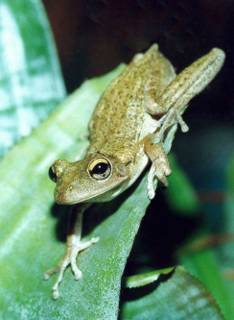Snapped this image just outside the front door one evening!
These little guys are typically easy to photograph because they tend to stay put until you poke at to much them.
Cuban Tree Frog
Osteopilus septentrionalis
Description:
The Cuban Tree Frog, like many other frogs in our country, was introduced to and is now well established in South Florida. It is the largest tree frog now existing in the North America. They are nocturnal. Males are 1-3.5 inches while females grow up to 5 inches. Males are not only smaller than the female, but they have darker throats and nuptial pads in times of breeding. Their skin is warty and color can be green, bronze, or grey marbled with darker brown and faint banding on their limbs. The skin on the top of their head is fused to the skull. A calling cuban tree frog's voice is described as "a variably pitched, slightly rasping or grating snore". Cubans have a wide head and large eyes. The sticky discs on their fingers and toes are pretty large.
Habitat:
Temperatures should remain in the upper 70s to low 80s in the daytime and at night remain in the 70s. They can be maintained much like White's Tree Frogs, and are pretty easy to keep. Cubans love to hide in moist, covered ares like trees or shrubs or around houses. Keeping this frog with other small frogs is strongly discouraged, but I have kept them with firebellied toads without any problem. Just be careful. It secretes toxins that are quite noxious, so do not rub your eyes after handling them. In captivity, it requires a large, tall aquarium. Because of its size, only robust plants and climbing branches should be provided.Feeding:
When mature, will consume the standard crickets as prey as well as larger prey such as baby mice.
Breeding:
Cuban Tree Frogs breed easily after a light winter chill sometime between May and October. During this time, the male develops a bronze shimmer and large green patches making him quite a handsome frog. Their egg masses contain up to 2,000 eggs and are often deposited in lakes, ponds, drainage ditches, swimming pools, and cisterns. The tadpoles hatch in 1-2 days and will eat tropical fish flakes. They will metamorphosize in 6-8 weeks and reach sexual maturity within one year.

